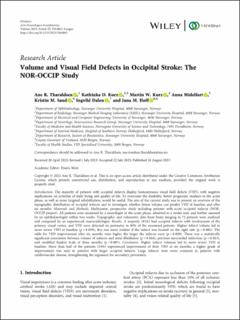| dc.contributor.author | Tharaldsen, Ane Roushan | |
| dc.contributor.author | Kurz, Kathinka Dæhli | |
| dc.contributor.author | Kurz, Martin | |
| dc.contributor.author | Midelfart, Anna | |
| dc.contributor.author | Sand, Kristin Modalsli | |
| dc.contributor.author | Dalen, Ingvild | |
| dc.contributor.author | Hoff, Jana Midelfart | |
| dc.date.accessioned | 2023-10-11T07:56:28Z | |
| dc.date.available | 2023-10-11T07:56:28Z | |
| dc.date.created | 2023-10-09T13:11:02Z | |
| dc.date.issued | 2023-08 | |
| dc.identifier.citation | Tharaldsen, A.R., Kurz, K.D., Kurz, M.W., Middelfart, A., Sand, K.M., Dalen, I. & Hoff, J.M. (2023) Acta Neurologica Scandinavica. 2023, 3564863. | en_US |
| dc.identifier.issn | 0001-6314 | |
| dc.identifier.uri | https://hdl.handle.net/11250/3095696 | |
| dc.description.abstract | Introduction. The majority of patients with occipital infarcts display homonymous visual field defects (VFD), with negative implications on activities of daily living and quality of life. To overcome the disability, better prognostic markers in the acute phase, as well as more targeted rehabilitation, would be useful. The aim of the current study was to present an overview of the topographic distribution of occipital infarcts and to investigate whether lesion volume can predict VFD at baseline and after six months. Materials and Methods. Multicenter, prospective study including patients with acute occipital infarcts (NOR-OCCIP project). All patients were examined by a neurologist in the acute phase, admitted to a stroke unit, and further assessed by an ophthalmologist within two weeks. Topographic and volumetric data from brain imaging in 72 patients were analyzed and computed by an experienced neuroradiologist. Results. A majority (81%) had occipital infarcts with involvement of the primary visual cortex, and VFD were detected on perimetry in 80% of the examined patients. Higher infarct volume led to more severe VFD at baseline (p = 0,019); this was more evident if the infarct was located on the right side (p = 0.001). The odds for VFD improvement after six months were higher the larger the infarcts were (p = 0,020). There was a statistically significant association between volume of infarcts and atrial fibrillation (p = 0,016), previous myocardial infarction (p = 0,023), and modified Rankin Scale at three months (p = 0,007). Conclusion. Higher infarct volumes led to more severe VFD at baseline. More than half of the patients (54%) experienced improvement of their VFD at six months; a higher grade of improvement was seen in patients with larger occipital infarcts. Large infarcts were more common in patients with cardiovascular disease, strengthening the argument for secondary prevention. | en_US |
| dc.language.iso | eng | en_US |
| dc.publisher | Hindawi | en_US |
| dc.rights | Navngivelse 4.0 Internasjonal | * |
| dc.rights.uri | http://creativecommons.org/licenses/by/4.0/deed.no | * |
| dc.subject | slag | en_US |
| dc.subject | synstap | en_US |
| dc.subject | synsforstyrrelser | en_US |
| dc.title | Volume and Visual Field Defects in Occipital Stroke: The NOR-OCCIP Study | en_US |
| dc.type | Peer reviewed | en_US |
| dc.type | Journal article | en_US |
| dc.description.version | publishedVersion | en_US |
| dc.rights.holder | © 2023 Ane R. Tharaldsen et al. | en_US |
| dc.subject.nsi | VDP::Medisinske Fag: 700::Klinisk medisinske fag: 750::Nevrologi: 752 | en_US |
| dc.source.volume | 2023 | en_US |
| dc.source.journal | Acta Neurologica Scandinavica | en_US |
| dc.identifier.doi | 10.1155/2023/3564863 | |
| dc.identifier.cristin | 2182909 | |
| dc.source.articlenumber | 3564863 | en_US |
| cristin.ispublished | true | |
| cristin.fulltext | original | |
| cristin.qualitycode | 1 | |

